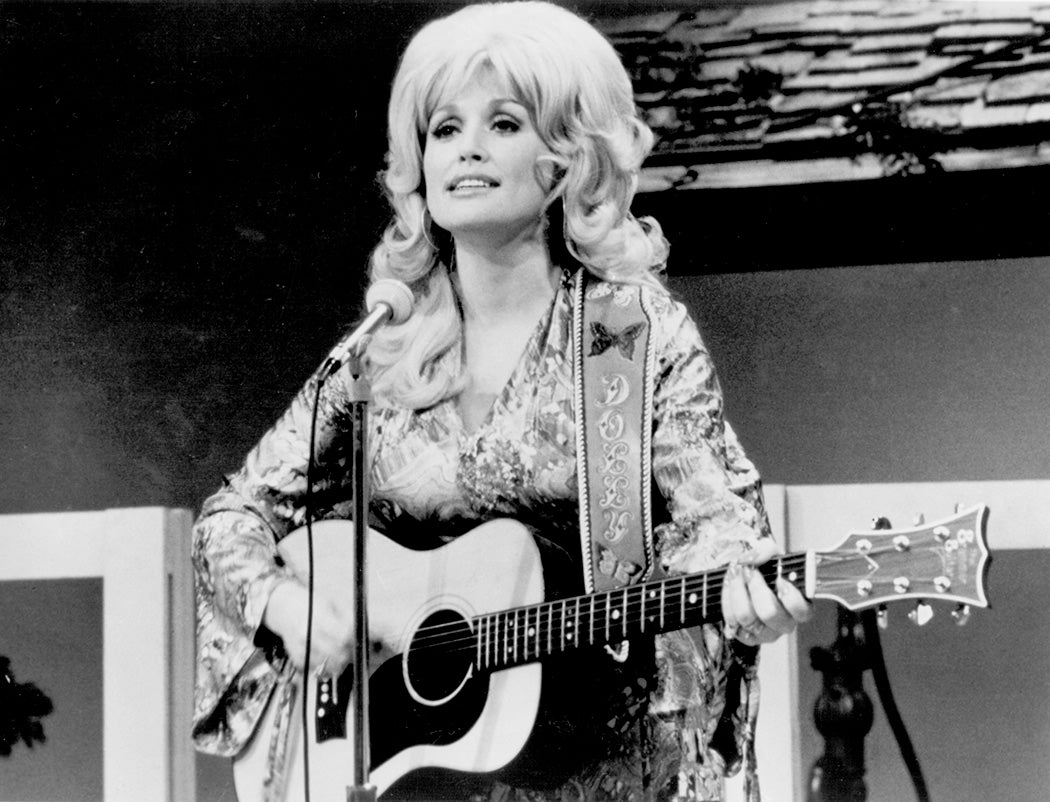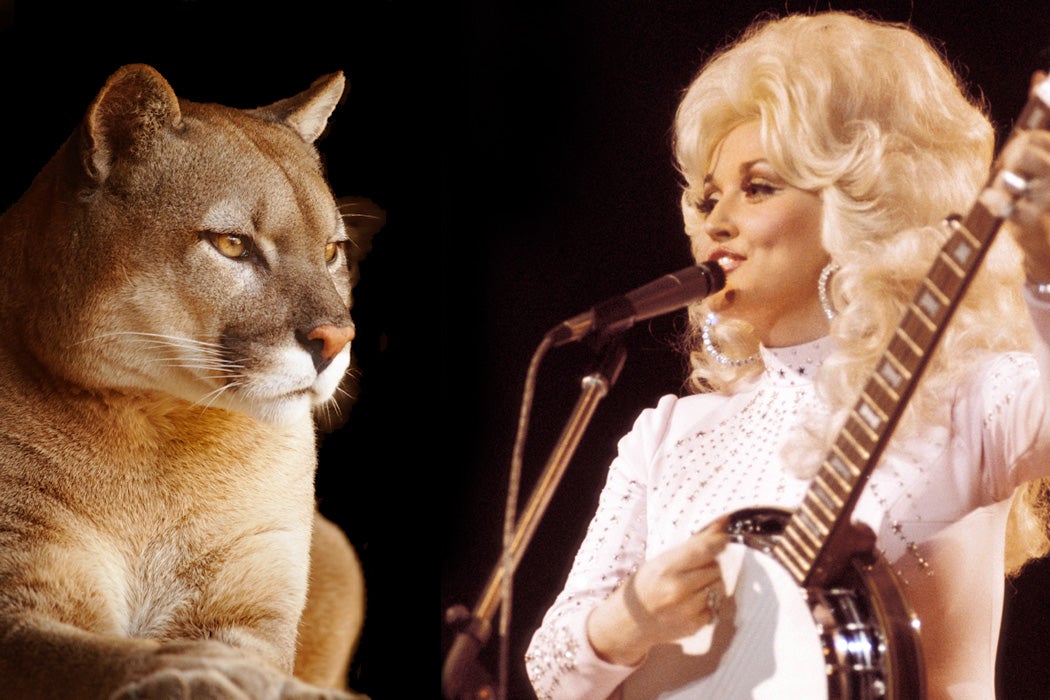Dolly Parton, an icon for rural Appalachians, especially those from Tennessee, is perhaps the most famous musician from the region. Millions of people recognize her telltale twang. Parton has several nicknames, including “the Queen of Country” and “the Backwoods Barbie.” Tabloids have also called Parton a “cougar.” It’s an odd moniker on several levels.
Colloquially, a cougar is an older woman who pursues romantic relationships with younger men, but Parton’s marriage does not fit the mold of a stereotypical cougar. The singer has stuck with her slightly older partner Carl Thomas Dean since 1966, a fact that surprised interviewers in the earlier years of Parton’s career. In 1977, Barbara Walters asked Parton: “Is there any hanky-panky in the bus?” and expressed skepticism that Dean and Parton could remain faithful from a distance.
Weekly Newsletter
Calling a woman a cougar may have something to do with the cat’s high-pitched scream, which sounds like a woman shrieking. Male cougars can also scream, but wildlife experts tend to attribute the chilling sound to female cougars in estrus. One may imagine a cougar screaming in the night, desperate for a mate. After decades of habitat loss and poaching, cougars are extinct or dwindling in some regions. At the same time, in the depths of the mountains, neither cougars nor women are truly alone. Both make themselves known through their songs.
In other words, comparing Dolly Parton to an actual cougar is more revealing than comparing her to the cultural stereotype of a cougar. The label of “cougar” may demean some women for their sexuality, but perhaps we can hear something of our own humanity echoing in the cries of these wild mountain cats.
Of Cat-Skin Banjos
Growing up in Appalachia, I heard women shouting every day. Voices, especially high-pitched ones, echoed throughout the holler where I lived with my grandparents. I still remember what the women’s cries sounded like as they called to their cattle or chided their children for tangling a clothesline. Because of the acoustics of the landscape, these women’s voices resonated.
As the historian Ingrid Winther Scobie notes in the Public Historian, women’s voices, including Dolly Parton’s, carry the chorus of Appalachia’s oral history. While Appalachian people are often misrepresented in pop culture, bluegrass songs offer a revolutionary platform for mountain women to reclaim their voices, singing about the good, bad, and ugly realities of their lives that often go unseen in the mountains.
For generations, cats have helped women sing these stories—quite literally. Appalachians killed feral cats and used their skins and innards to make banjos and tambourines. These instruments are made of a hollow frame, often wooden or metal, and the drum is covered with a membrane. Before spaying and neutering became possibilities for controlling cat populations, some mountain folk culled the stray cats. Resourceful musicians wouldn’t let the cats go to waste. They’d turn cat skins into instruments. Then, they’d turn their instruments into storytelling tools.
Foxfire, a nonprofit organization that preserves Appalachian traditions, interviewed Appalachian musicians for their 1975 anthology. In that book, several master craftsmen, like Stanley Hicks and M.C. Worley, explained how they learned to use housecat skins to make banjos. Some banjo pickers believe that the skin of an agile cat helps them strum with the surety of quick, cat-like reflexes.
Bluegrass music is famous for its emotional range, from playful, spontaneous stories about tricksters to tear-jerking tales of lost love. Likewise, the mountain lion is the only wild cat that can purr and scream. Cougars’ vocalizations reflect the pathos characteristic of bluegrass music. And rumor holds that cougar-hide banjos produce sweet chords and wailing notes.
The Wailing Woman of the Great Smoky Mountains
Appalachian women have long played a vital role in making and playing banjos, from skinning a cat to plucking out a tune. While Dolly Parton might not play a cat-skin banjo, she was raised alongside these feline musical and cultural influences. When Parton strums the banjo, she uses the most popular country music style: “clawhammer.” Especially with her long nails, Parton holds her hand in a clawlike shape over the strings.
If a cougar’s cry is a symbol of the North American wilderness, Dolly Parton’s voice is the model for Appalachian song. International radio stations and television channels have played Parton’s songs for decades. She’s mastered that vibrato that’s characteristic of country music—her voice an airy soprano with a touch of gravel.

In Appalachian folklore, mountain cats and women share a sacred relationship—and a song. In one such folktale, a Cherokee woman named Running Deer fights an evil creature, an Ew’ah, that plagues her village. The Ew’ah’s eyes drive humans to madness. Running Deer wears a feline mask and appeals to the spirit of the mountain lion to help her defeat the Ew’ah. A victorious Running Deer sings as she returns home: a song to mourn the Ew’ah’s victims, but also to rejoice in its demise. In some versions of the tale, Running Deer’s spirit continues to live on as a wild cat. A cougar’s wails may remind us that Running Deer is still singing through the mountains to scare away evil spirits and protect her tribe’s descendants.
Where Running Deer’s song helps to protect her tribe, Dolly Parton’s thousands of songs help to protect the memory of her Appalachian home. Many of these songs build an archive of her life in rural Tennessee. Take, for example, “My Tennessee Mountain Home.” Parton sings an oral history of growing up in an impoverished but rich-in-spirit region:
Sittin’ on the front porch on a summer afternoon
In a straight back chair on two legs, leans against the wall
Watch the kids a’ playin’ with June bugs on a string
And chase the glowin’ fireflies when evenin’ shadows fall
In my Tennessee mountain home
Life is as peaceful as a baby’s sigh
In my Tennessee mountain home
Crickets sing in the fields nearby
Parton is the lead vocalist on this song. But at the line, “in my Tennessee mountain home,” other voices swell. The lyrics are an anthem for other poor Appalachians who have lived in similar circumstances. Parton’s song, like Running Deer’s, is bittersweet and full of nostalgia. She, like the other Appalachians singing along, holds onto treasured memories of growing up in the mountains, even if that life was marked by financial insecurity.
But for many Appalachians, these memories are just that: memories. Small Tennessee homesteads are disappearing as cities like Knoxville and Johnson City gentrify. Ironically, Parton spent millions of dollars recreating her family’s tiny cabin. Fortunately, Parton’s songs, like “My Tennessee Mountain Home” and “Coat of Many Colors,” provide a balm for other Appalachians who face rapid environmental changes. Drafty cabins and hand-stitched clothes are precious to the generations of families who needed these items to survive.
When these places and heirlooms are lost to time, Appalachians depend on oral history—like the stories a mother tells at bedtime or the songs Parton sings on the radio—to teach their children about these rural experiences. Parton calls herself a “songteller” because she prizes this sense of storytelling in her music. Songs like “My Tennessee Mountain Home” convey the tangled-up emotions typical of bluegrass: mourning the places that have been lost to time, but celebrating the fact that Appalachians themselves live on.
Singing It Out
Parton and cougars share a language: cries. Does a cougar’s wail give hope to mountain people? And can Dolly Parton’s mournful bluegrass songs help Appalachians heal?
Cougars used to live across the Appalachian Mountains until poaching and habitat loss killed off the wild cats in the early 1900s. Although mountain lions still live in other regions of the US, the US Fish and Wildlife Service declared the cats extinct on the East Coast in 2018. While wildlife experts state that the cougar is mostly gone from the area, locals continue to report hearing the creature. Many of these encounters may involve male cats that have wandered into the mountains from the West. But each wail in the night sparks awestruck hope.
I remember my grandmother gossiping about a mountain lion sighting with one of her friends; “A deacon at the church heard a cougar up on Bee Tree Road. I reckon it warn’t no bobcat, nary a coyote. He’s heard those before. He thinks it might be a female cat. It screamed like a singing woman.”
Why might a female cougar excite locals more than a male? Chris Bolgiano, an expert on mountain lions, writes:
It’s already well-established that some western cougars move eastward… Even if other males make it here, though, females usually stay close to home. Some biologists doubt that cougars can build viable populations in the East without… reintroducing a few females.
In other words, more female cougars in a region indicates a more stable cougar population. Cougars are the undercats when it comes to thriving on the East Coast. When female mountain lions return, Appalachians may feel as though the ravaged mountain ecosystem, bald from mountaintop removal, has finally healed.
Appalachians wait for this environmental healing as they listen at night to hear a cougar crying. But Dolly Parton’s tear-jerking music may provide another type of healing: the therapeutic power of a sad song.
Parton loves “sad-ass songs.” In a 2020 interview with Stephen Colbert, Parton said, “Momma used to sing all those old songs brought over from the Old World… So many of those songs were sad… some of them were just plum pitiful.” She goes on to describe a song her mother taught her, called “Bury Me Beneath the Willow.” It’s a bluegrass classic about a suicidal woman who wishes to be buried under a willow tree. In the interview, Parton suddenly starts to sing the song, and she’s unsurprised when Colbert begins to cry. Parton said: “We used to cry when Momma would sing, though. Momma would cry, and we’d cry… It cleanses your soul. Water’s good to wash it out. That’s what tears are for.”

Parton knows first-hand that crying is cathartic. Many of her most popular songs like “Jolene” and “Working 9 to 5” address difficult emotions like exhaustion, jealousy, and grief. While many of us may have jammed out to one of these Parton songs on a bad day, music may have a larger impact on our health. The music scholar Lauren Dimaio researches music therapy. She describes how some hospice patients feel emotional and physical relief after listening to songs like Dolly Parton’s “I Will Always Love You.” Why? Sandra Garrido, an expert on music psychology, explains that sad music has multiple psychological benefits. First, sad music can encourage listeners to reflect on and accept their emotions instead of ignoring those feelings. People can use a sad song as a healthy opportunity to cry and cope. Second, these songs can dissuade loneliness. People who listen to these emotional songs may find some camaraderie and feel as though they’re not alone.
When I think of women wailing in the mountains, I think of my own grandmother. She was born not far from where Parton grew up, in another modest Appalachian home. After a difficult birth, my grandmother was silent and seemingly stillborn. The women in the home bundled up my grandmother’s tiny body and tossed her out into the January storm. When my grandmother hit the snow, she began to cry. Her cries proved that, against all odds, she was alive. Her wails provided generations of an Appalachian family with the gift of life, so that we, too, might cry.
These stories of wailing women, from Parton to Running Deer, celebrate the endurance of Appalachian culture against great odds. Bluegrass music is deeply rooted in women’s history, and cats have provided the gift of music to generations of songtellers. So long as women live to tell the stories of Appalachia, sad bluegrass songs will survive another day.
Support JSTOR Daily! Join our new membership program on Patreon today.







